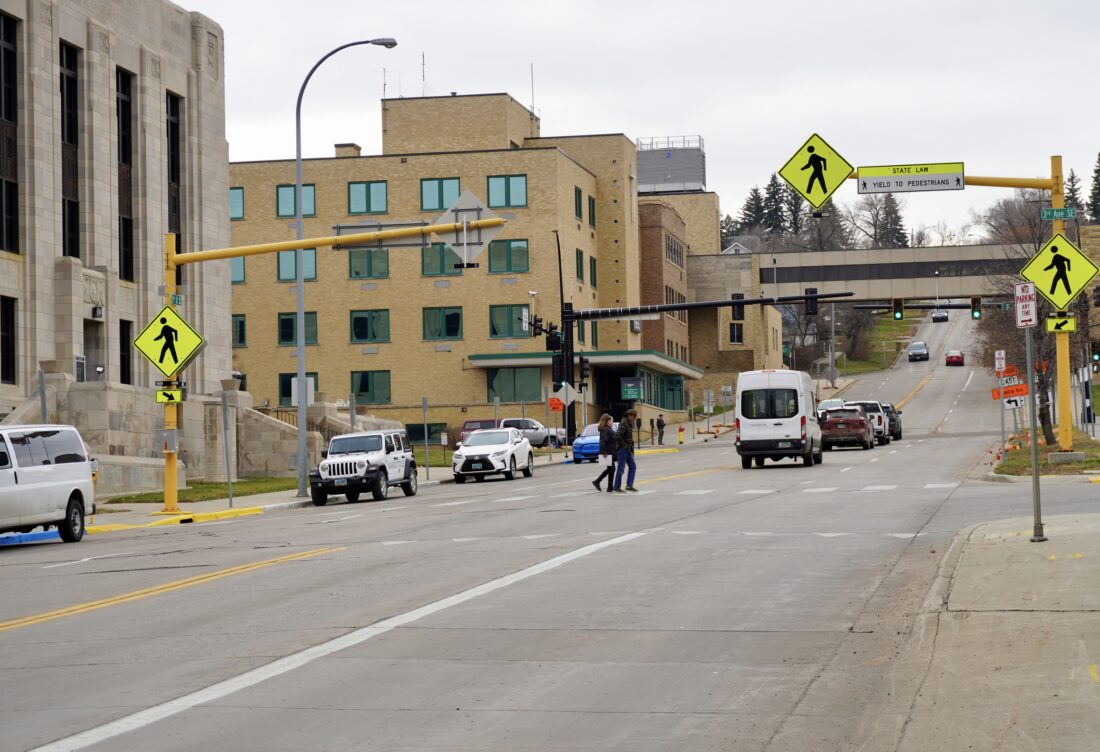Council debates proposed pedestrian projects
Three projects advance for federal aid

Jill Schramm/MDN Third Street Southeast in front of the Ward County Administration Building and Courthouse sees vehicle and pedestrian traffic Wednesday. The Minot City Council voted to pursue federal funds for reconstruction of a section of Third Street and is holding a public input meeting on the project Thursday, Nov. 20.
Reconstruction of Third Street, school curb ramps and a pedestrian beacon near the fairgrounds moved closer to getting into the North Dakota Department of Transportation’s federal funding program during the Minot City Council meeting Monday, Nov. 17. However, there was debate over the pedestrian projects should be included.
The proposed curb ramp replacement project in the Fifth and Seventh Avenue corridor between Bel Air and Longfellow Elementary schools narrowly won support.
Council member Mike Blessum opposed initiating a roughly $1.16 million project to install new ramps, which would require nearly $500,000 in city funds. It adds some accessibility but the city has higher priorities, he said.
Council member Lisa Olson said pedestrians are a minority in the transportation arena but they are an important minority.
“We owe it to our pedestrian public to offer them the best situation possible,” she said.
An upgrade to existing curb ramps would bring them in compliance with the latest federal requirements and provisions of the Americans with Disabilities Act, according to the city’s engineering department. Compliance is typically sought as streets are reconstructed or sidewalk projects are initiated, but if grant funds are available, ramps could be replaced at an accelerated rate, the council was informed.
The council voted 4-3 to advance the project, with opposition from Blessum, Rob Fuller and Scott Samuelson.
The proposed beacon project would replace pedestrian signals on Burdick Expressway near the fairgrounds with overhead rectangular rapid flashing beacons. The beacons would be similar to those in front of the Ward County Courthouse and Administration Building and near Roosevelt Park and Zoo. Both of those signals were installed with federal grants, the engineering department reported. Because the signals are on a federal highway, the city’s cost share would be 5%.
Blessum said it appears to be a case of looking for a project because money is available instead of finding a project necessary and then seeking funding.
Council member Paul Pitner reminded the council of a previous decision to keep signals at that location for safety reasons.
“If we are going to make it safe – make it safe,” he said.
The council voted unanimously in September 2024 to reject a proposal to remove the traffic signals at the East Burdick Expressway and Eighth Avenue Southeast intersection. The proposal came from an engineering determination that the signals are unwarranted. However, the NDDOT had recommended flashing pedestrian signals be installed and conversion of the intersection from a two-way to a four-way stop during special events at the fairgrounds.
Samuelson said pedestrians use the intersection for a number of events on the fairgrounds and not just during the State Fair.
“It needs to be safer and it really should have been done a long time ago,” he said.
The council approved advancing the beacon project on a 5-2 vote, with Blessum and Fuller opposed.
The council voted 7-0 to advance the reconstruction of Third Street East downtown and the Central Avenue intersection. That project is the subject of a public input meeting Thursday, Nov. 20, at 6:30 p.m. in Minot City Hall.
The approved projects now go to the Central Dakota Metropolitan Planning Organization for review and potential advancement to the NDDOT for consideration for federal grants in 2028-2030.
Traffic code amended
The council also approved an updated criminal traffic ordinance on final reading that adopts new state fines, with a couple of changes.
Cities cannot deviate from state fines on speeding offenses but can adjust fines for moving violations. On the ordinance’s first reading, the council kept fines for lacking liability insurance at $300 for a first offense and $600 for a second offense rather than cut those amounts in half to match a change made by the state.
Council member Scott Samuelson, who advocated for keeping the fines for lack of liability insurance, on Monday asked the council to leave the fine for using a wireless communication device while driving at $200. Legislators had reduced the fine to $100.
“This is a huge problem. I see it every day,” Samuelson said of phone use by drivers. “I don’t think we are going to correct any of that by lowering the fine for it.”
The council voted unanimously to leave the fine at $200 and give final approval to the revised ordinance.
Development debate
Additional discussion occurred on a developer’s request to post a bond guaranteeing the construction of a walking path next year in Highlands at North Hill 8th Addition in northwest Minot because it cannot be completed this year. The planned unit development agreement with the city requires the walking path.
Fuller pointed out there already are 8,222 feet of sidewalk in the subdivision, which is being held up by 385 feet of walking path “that nobody wants.” He said the city, parks and residents have no interest in maintaining the walking path, including clearing snow in the winter.
“We’re forcing this developer to build a sidewalk that goes nowhere that nobody is going to maintain,” he said.
Pitner argued for easing the process for amending a developer’s agreement rather than disregarding the walking path requirement. He noted other stalled developments could face similar situations in which their development agreements are outdated. Easing the process of making revisions would benefit them as well, he said.
“If you don’t like that process, let’s look at the process,” he said. “To me, to go outside of procedure is not right.”
For staff consideration, Pitner introduced an option of switching from a process of notarized signatures from residents to a public hearing process to amend a developer’s agreement.
The council voted 5-1, with Fuller dissenting, to allow the developer to post a bond to complete the walking path next year, which also will give the council time to address the development agreement process. As a home builder in the development, council member Mike Hayes abstained.




